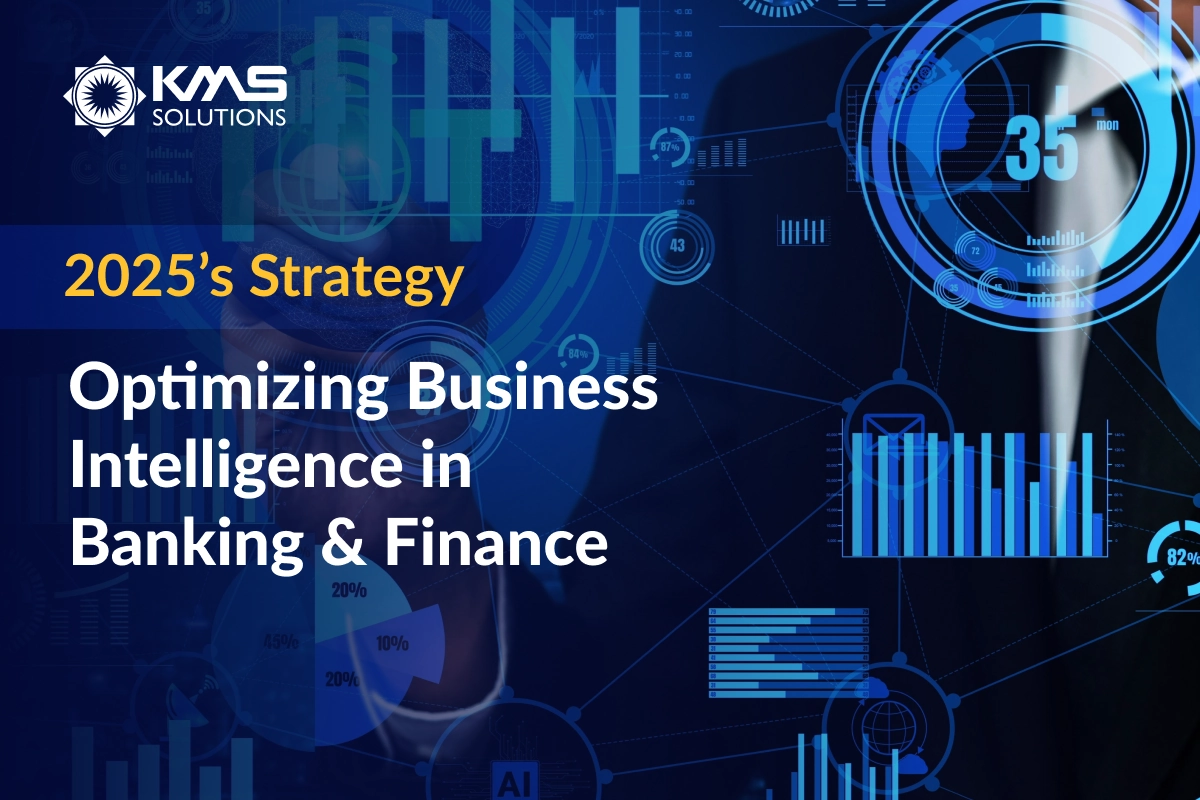Business intelligence (BI) is transforming the operations of banks and financial services organizations at an unprecedented pace. In an industry where data is essential, BI is an indispensable resource that enables banks to gain profound insights into customer behaviors, and make informed decisions that enhance profitability.
Since implementing effective business intelligence practices has become a necessity, not just an option, for BFSI businesses, this article will take an in-depth look at how BI is transforming banking operations. We’ll explore the key applications of BI in the banking industry and share key strategies for optimizing your BI approach to drive success and innovation
What is Business Intelligence (BI) in Banking and Finance Industry?
Business intelligence (BI) encompasses technologies, processes, and architectures designed to collect, clean, and transform raw data into actionable insights. It involves a suite of software applications and services that convert data into meaningful intelligence, influencing operational, strategic, and tactical decision-making.
The banking industry is undergoing a significant transformation with the adoption of BI tools and practices. According to the SAS survey ‘Banking in 2035’, 48% of executives identified technology and advanced data analytics as the top digital capabilities their organizations must leverage to stay competitive.
Banks, investment firms, and financial institutions are increasingly adopting BI solutions as essential tools to gain deeper insights into their operations, changing market trends, and customer behaviors. Additionally, BI strengthens fraud detection capabilities and enhances security measures, contributing to overall business resilience. By leveraging BI, banks and financial organizations can maximize profitability and achieve sustainable growth.
Benefits of BI in the BFSI Industry
BI is transforming the banking sector by providing tools to analyze trends, identify patterns, and deliver real-time reporting. Below are some of the key benefits of BI in the industry:
- Operational Efficiency: By automating repetitive tasks and streamlining processes, BI improves resource allocation and reduces costs, leading to faster response times and optimized workflows.
- Enhanced Decision-Making: BI systems offer real-time data access, enabling banks to make faster, more informed decisions. By analyzing customer preferences, market trends, and financial performance, banks can develop personalized services that boost satisfaction and loyalty.
- Regulatory & Standard Compliance: BI simplifies adherence to complex regulations by generating reports and audit trails, helping banks avoid fines and ensuring compliance.
- Fraud Detection: Advanced BI tools can detect anomalies and unusual transaction patterns in real time, enhancing fraud prevention efforts. By leveraging BI, banks can also manage risks like cyber threats and geopolitical uncertainty by leveraging historical data and predictive analytics. They support credit risk management, fraud detection, and regulatory compliance.
- Cost Reduction: BI identifies inefficiencies in processes and underperforming products, guiding resource allocation and budget management to reduce operational costs.
- Forecasting and Planning: With accurate financial forecasting, BI helps banks anticipate future challenges, such as shifts in interest rates or economic downturns, and develop strategies to address them.
Applications of Business Intelligence in Banking and Finance
BI solutions have gained popularity for enabling banks and financial institutions to utilize their data to improve customer experiences. Here are some common uses of BI in the BFSI sector:
1. Customer Trend Prediction
Understanding user needs is crucial for achieving a bank’s objectives and driving profitability. Banks provide a wide range of financial services to both individuals and businesses, from managing savings accounts and funds to offering loans, credit cards, and insurance products.
BI plays an essential role in analyzing the vast amounts of data generated daily to identify emerging trends in customer preferences and demands. For instance, are home loan applications declining? Are more customers investing in a specific mutual fund? Answering these questions enables bank management to adapt their financial products and services to better align with customer needs.
2. Fraud Detection and Prevention
There have been 1,100 online banking cybersecurity incidents reported in 2023 in Australia, according to the Australian Signals Directorate (ASD).
Using BI tools can help banks enable the real-time monitoring of transactions, helping identify suspicious activities and potential fraud. By analyzing patterns and anomalies in transaction data, banks can detect fraudulent behavior early, preventing financial losses and minimizing risk. BI solutions leverage machine learning (ML) algorithms to continuously improve the detection of unusual patterns in large datasets.
For instance, in the payment processing in Fintech software, BI uses ML algorithms to detect patterns and anomalies in transactional data. BI can quickly identify transactions that deviate from the established baseline, flagging suspicious activities such as large transactions, those originating from unusual locations, or a series of rapid transactions.
3. Compliance Assurance
The banking industry must comply with various regulations established by national and global authorities, such as PCI DSS, GDPR, electronic Know Your Customers (e-KYC), and anti-money laundering (AML) standards. Banks are required to regularly submit reports and updates to the relevant regulatory bodies.
BI streamlines compliance with regulatory requirements by automating data collection and reporting, significantly reducing the risk of non-compliance. With BI, banks can consistently meet industry regulations, protecting themselves from potential penalties.
- Regulatory Reporting Automation: BI enables banks to automate the gathering and consolidation of data needed for regulatory reporting. This minimizes the risk of human errors and ensures that submissions to regulatory bodies are timely and accurate.
- Audit Trail and Data Governance: BI tools provide a clear audit trail, ensuring proper data governance and compliance with data protection regulations. This transparency allows banks to demonstrate data lineage and uphold data privacy standards.
4. Investment and Portfolio Management
Financial institutions use BI for portfolio management by analyzing market trends, asset performance, and investment risk. BI helps investment managers make data-driven decisions, identify new investment opportunities, and optimize portfolios to achieve higher returns while managing risk effectively.
Some examples of BI in an investment platform include:
- Risk Assessment: BI tools offer risk modeling features, allowing investment analysts to evaluate the risks tied to various asset classes and investment strategies.
- Performance Monitoring: BI dashboards facilitate real-time tracking of investment portfolio performance, enabling investors to make informed decisions based on up-to-date market conditions.
5. Churn Prediction and Retention Strategies
Customer retention is essential for maintaining a strong customer base. A bank relies on long-term customers who will stay for years to come. Offering personalized services and ensuring a high-quality customer experience are key factors in fostering retention.
BI tools can help identify customers who may be at risk of leaving for a competitor or who might stop engaging with the bank. These tools also provide insights into the reasons behind this trend, allowing banks to take preventive measures. Executives like CEOs, CFOs, and other leaders can analyze both historical and real-time data to recognize patterns and develop strategies to address the issue.
Strategy for Optimizing BI in Your Financial Services Business
BI plays a pivotal role in transforming raw data into actionable insights, driving strategic decision-making, and fostering competitive advantages. However, to maximize the potential of BI, financial institutions must adopt a well-defined optimization strategy.
Here’s a comprehensive guide to enhancing BI capabilities in the banking and finance sector:
Align BI Objectives with Business Goals
Start by identifying the core objectives of your BI strategy. These could include enhancing customer retention, streamlining regulatory compliance, improving operational efficiency, or identifying new revenue streams. Thus, ensure BI initiatives align with your organizational objectives to provide targeted insights that drive measurable outcomes.
Some example questions that you can answer in this stage include:
- What specific challenges or pain points that your organization is currently facing that BI can help address?
- What gaps exist between current BI capabilities and the organization’s goals?
- How can BI insights improve decision-making at both the strategic and operational levels?
Gather and Organize Your Data
Data serves as the foundation of any successful business intelligence strategy. To unlock the potential of BI, it’s essential to establish a method for collecting, organizing, and transforming data into actionable insights. A sound data plan is a crucial component of this process:
- Define data source: As a banking institution, you will have data from multiple sources- users, projects, partners, sales, marketing, etc. Thus, the first step is to determine all these data sources and their essences. The types of data required can include stakeholders’ information, transaction records, financial metrics, and external market data. Moreover, you also should evaluate the quality, volume, and sources of existing data.
- Visualize your data: Develop a clear approach for presenting data insights through dashboards, charts, and reports. The strategy will concentrate on two key things: What metrics will you prioritize in your dashboard, and how will you visualize them?
Choose the Right BI Tools and Technology
The best practice here is to select BI tools that cater to your business requirements, offering features like advanced analytics, real-time monitoring, predictive modeling, and data visualization. Consider scalable and user-friendly solutions such as Power BI, Tableau, or Qlik, which can integrate with existing systems and support growth.
Ensure Data Governance and Security
Banks and financial institutions should develop a comprehensive data governance framework to ensure data accuracy, consistency, and compliance with regulations like GDPR, PCI DSS, or AML (anti-money laundering). A layered approach to security ensures comprehensive protection against breaches and cyber threats.
- Encryption: Secure data both at rest and in transit using advanced encryption protocols. This ensures that even if data is intercepted, it remains unreadable to unauthorized users.
- Access Controls: Implement role-based access controls (RBAC) to limit data access to only those employees or systems that require it. Use multifactor authentication (MFA) to strengthen login security.
Develop Your BI Team
Building a dedicated BI team is crucial for successfully implementing your BI strategy. Since business intelligence relies on data from multiple sources, it’s important to include stakeholders from various departments to ensure comprehensive representation and collaboration.
Some typical roles required in the BI team include business analyst, BI infrastructure architect, database administrator, project manager, developer, and quality assurance.
The BI team also needs to have proficient skillsets to incorporate AI/ML to uncover deeper insights and improve decision-making processes.
Invest in Training and Support
To better optimize business intelligence during your BI team, it’s worth considering providing training courses to employees on how to use BI tools effectively and interpret insights.
Fintech can also offer ongoing support to address challenges and encourage the adoption of BI across the organization.
How KMS Solutions’ Business Intelligence Team Can Help Banks and Financial Institutions?
The integration of Business Intelligence (BI) in the banking and finance sectors has become a critical necessity rather than just an innovation. BI is instrumental in transforming the way banking and finance industries function in today’s data-driven landscape. It enables BFSI organizations to harness their vast data resources efficiently, translating them into actionable insights that support informed decision-making and boost operational effectiveness.
KMS Solutions’ BI team offers specialized services to help financial institutions unlock the full potential of their data, addressing industry challenges while driving sustainable growth. Our BI team collaborates with banks to design solutions customized to their unique needs. Whether the focus is on improving compliance, detecting fraud, personalizing customer experiences, or optimizing internal operations, KMS tailors strategies and tools to address these objectives.
Wonder how our business intelligence team can help your business? Contact our experts now!











